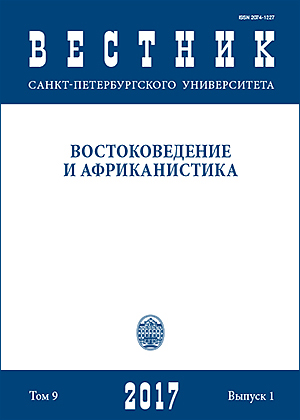Language and Food Safety: the “Zombie Meat” scandal
DOI:
https://doi.org/10.21638/11701/spbu13.2017.107Аннотация
Представленная статья затрагивает несколько весьма актуальных для современного Китая проблем. Во-первых, — проблема продовольственной безопасности, которая связана с тем, что в последние годы в КНР регулярно возникают скандалы, вызванные появлением в продаже опасных для здоровья продуктов питания. На примере обсуждения одного из таких скандалов в статье исследуются особенности репрезентации болезненных для общества тем в китайских СМИ. В основу статьи положены материалы двух СМИ, относящихся к разным категориям, — это информационный правительственный сайт и популярный китайский сервис микроблогов Weibo. В статье подробно анализируется инцидент, произошедший в 2015 г., — захват властями партии контрабандного замороженного мяса, так называемого «мяса-зомби» возрастом 40 лет, для улучшения товарного вида которого использовались опасные химические вещества.
В статье приведен социолингвистический и текстуальный анализ электронных публикаций, появившихся в течение первой недели после скандала. Предметом специального исследования является то, как китайские традиционные (правительственные) и новые (условно либеральные) СМИ конструируют язык и когнитивные структуры вокруг проблемы продовольственной безопасности. Проводится анализ факта присутствия в электронных публикациях и комментариях следующих пяти фреймов: определение субъектов ответственности, воздействие на человека, экономические последствия, решения и последствия, доверие людей. Каждый фрейм подразделяется на пять подфреймов — пять наиболее существенных вопросов, совокупность которых формирует данную когнитивную структуру.
Результатом исследования являются выводы о том, насколько популярен каждый из фреймов в каждом из двух рассматриваемых СМИ, ответы на какие из 25 вопросов присутствуют в публикациях.
Статья может быть полезна специалистам, интересующимся как проблемами современного китайского общества, так и особенностями репрезентации злободневных тем в СМИ и методами воздействия СМИ на аудиторию.
Ключевые слова:
безопасность пищевых продуктов, «мясо-зомби», китайские СМИ
Скачивания
Библиографические ссылки
Загрузки
Опубликован
Как цитировать
Выпуск
Раздел
Лицензия
Статьи журнала «Вестник Санкт-Петербургского университета. Востоковедение и африканистика» находятся в открытом доступе и распространяются в соответствии с условиями Лицензионного Договора с Санкт-Петербургским государственным университетом, который бесплатно предоставляет авторам неограниченное распространение и самостоятельное архивирование.





